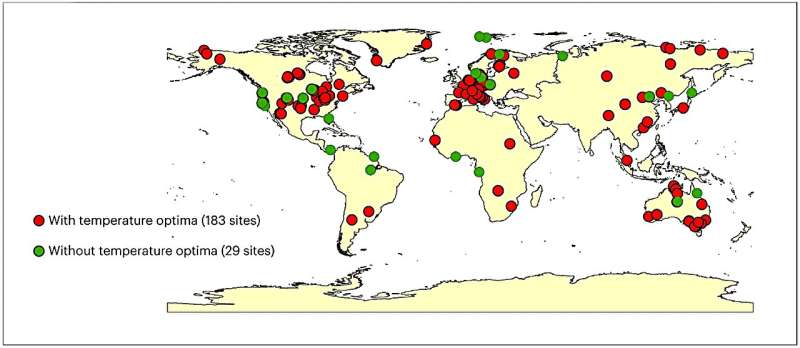This article has been reviewed according to Science X's editorial process and policies. Editors have highlighted the following attributes while ensuring the content's credibility:
fact-checked
peer-reviewed publication
trusted source
proofread
Researchers find evidence for widespread thermal optimality of ecosystem respiration

Terrestrial ecosystems respire nearly 120–130 Gt of carbon into the atmosphere each year. But it is not yet clear how ecosystem respiration will change under global warming.
Prof. Niu Shuli's lab at the Institute of Geographic Sciences and Natural Resources Research of the Chinese Academy of Sciences (CAS) found that ecosystem respiration shows a non-monotonic response to temperature, with respiration peaking at an optimum temperature and then declining with the increasing temperature. The optimum temperature of ecosystem respiration is closely correlated with the annual maximum daily temperature on a global scale. This work was published in Nature Ecology & Evolution.
The understanding of the temperature response of ecosystem respiration (ER) remains limited because ER is a sum of complex processes of autotrophic and heterotrophic respiration affected by many confounding factors.
Under the supervision of Prof. Niu, Chen Weinan analyzed the temperature response curves of ER at 212 sites from the global FLUXNET. They found that the temperature optima of ER existed at 183 sites widely distributed in different biomes around the globe.
In addition, the temperature optima of ER also increased linearly with annual maximum daily temperature (Tmax) across sites and vegetation types, suggesting thermal adaptation.
This study provides the first evidence for the widespread existence of thermal optima of ER and its adaptation with Tmax across different biomes over the globe, advancing the traditional understanding on temperature response functions of ER. The widespread existence of thermal optima of ER implies that respiration rates of terrestrial ecosystems may decrease rather than continue to increase at high temperatures.
More information: Weinan Chen et al, Evidence for widespread thermal optimality of ecosystem respiration, Nature Ecology & Evolution (2023). DOI: 10.1038/s41559-023-02121-w
Journal information: Nature Ecology & Evolution
Provided by Chinese Academy of Sciences

















